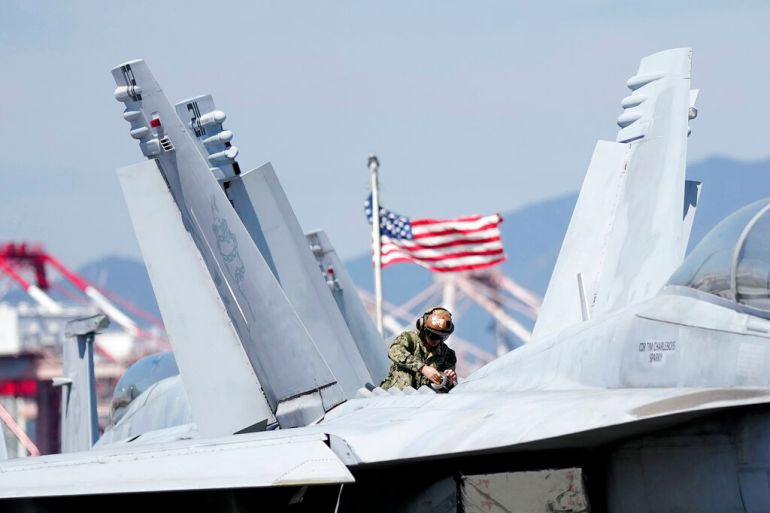US aircraft carrier starts joint military drills in South Korea
US military official says aircraft carrier’s visit is ‘clear and unambiguous demonstration’ of commitment to alliance.

A United States aircraft carrier and its accompanying ships have launched joint military exercises with South Korean forces as tensions with North Korea intensify.
The drills, which started on Monday off the Korean Peninsula’s east coast with the participation of the nuclear-powered USS Ronald Reagan aircraft carrier, came a day after North Korea tested another ballistic missile.
Keep reading
list of 3 itemsUS aircraft carrier Ronald Reagan arrives for South Korea drills
Fire in South Korean malls kills at least 7, search continues
The training, expected to last four days, also coincides with a visit by US Vice President Kamala Harris to Seoul later this week.
“The Ronald Reagan Strike Group’s visit is of strategic importance to the US and Republic of Korea relationship and is a clear and unambiguous demonstration of US commitment to the Alliance,” US Rear Admiral Buzz Donnelly, the strike group’s commander, said in a statement on Saturday.
The South Korean navy said the exercises are aimed at demonstrating the allies’ “powerful resolve to respond to North Korean provocations” and improving their ability to perform joint naval operations.
It is the first US-South Korea joint military training involving a US aircraft carrier since 2017.
Pyongyang has condemned previous US military deployments and joint drills as proof of hostile policies by Washington and Seoul.
North Korea has conducted a record number of weapons tests this year, launching dozens of ballistic rockets, including the first intercontinental ballistic missile in five years.
Sunday’s tested missiles flew 600km (370 miles) before falling into the waters off North Korea’s east coast, according to South Korean estimates.
Earlier this month, North Korea passed a law allowing it to carry out a preventive nuclear attack and declaring its status as a nuclear-armed state “irreversible”.
In response, the US and South Korean governments released a joint statement expressing concern about what they called “escalatory and destabilizing messaging related to nuclear weapons use” by North Korea.
“The United States reiterated its ironclad and unwavering commitment to draw on the full range of its military capabilities, including nuclear, conventional, missile defense, and other advanced non-nuclear capabilities, to provide extended deterrence for the ROK [the Republic of Korea/South Korea],” the statement said.
South Korea is not nuclear-armed, but it falls under Washington’s so-called “nuclear umbrella” — a US pledge to defend allies by all means possible in the case of a nuclear attack.
Former US President Donald Trump engaged in direct talks with his North Korean counterpart Kim Jong Un during his tenure, but high-level meetings between the two countries came to a halt under current President Joe Biden.
After the first meeting between Trump and Kim in 2018, the nations said in a joint statement that North Korea was committed to “work toward complete denuclearization of the Korean Peninsula”.
But the pledge was never followed by efforts to end the country’s nuclear weapons programme.
North Korea carried out its first nuclear weapon test in 2006, in violation of an international ban on such testing. Since then, the United Nations Security Council has unanimously passed numerous resolutions that imposed sanctions on the country over its nuclear programme.